I encountered Rahele’s work through this year’s Tomie de Paola SCBW illustrator competition where the prompt was: to illustrate a moment from a passage from Philip Pullman’s version of “Little Red Riding Hood” from FAIRY TALES FROM THE BROTHERS GRIMM (Viking, … Continue reading
Add a CommentViewing: Blog Posts Tagged with: little red riding hood, Most Recent at Top [Help]
Results 1 - 25 of 32
Blog: Miss Marple's Musings (Login to Add to MyJacketFlap)
JacketFlap tags: Interview, SCBWI, picture book, picture books, Marla Frazee, Maurice Sendak, Little Red Riding Hood, Illustrators, kay Nielsen, Illustrator interview, Iran, Renata Liwska, Feodor Rojankovsky, Errol Le Cain, Fritz Baumgarten, Hans Arnold, Kam?l ud-D?n Behz?d, Rahele Jompour Bell, Sultan Muhammad, Tomie Di Paola, Yuri Vasnetsov, Add a tag
Blog: The Children's Book Review (Login to Add to MyJacketFlap)
JacketFlap tags: Ages 4-8, Ages 9-12, Giveaways, Fairy Tales, Chapter Books, Author Interviews, Fractured Fairy Tales, Little Red Riding Hood, featured, Books for Girls, Fantasy: Supernatural Fiction, Liesl Shurtliff, Selfie and a Shelfie, Add a tag
Don’t miss Liesl Shurtliff’s new dark, humorous stand-alone middle grade novel RED: THE TRUE STORY OF RED RIDING HOOD (on sale April 12, 2016)!
Add a CommentBlog: OUPblog (Login to Add to MyJacketFlap)
JacketFlap tags: quiz, Literature, fairy tale, Cinderella, Rapunzel, little red riding hood, Multimedia, Hansel and Gretel, Jack and the Beanstalk, sleeping beauty, Jack Zipes, fairy stories, Oxford Reference, fairy tale characters, OR, oxford companion, Editor's Picks, *Featured, personality quiz, Online products, wicked witch, Quizzes & Polls, Arts & Humanities, classic fairytales, oxford online, Oxford Companion to Fairy Tales, character quiz, Add a tag
The magic of fairy tales doesn’t just lie in their romantic landscapes and timeless themes of good against evil. The best fairy tales are always populated with compelling and memorable characters – like the rags-to-riches princess, the gallant prince on horseback set to save the day, or the jealous and lonely evil king or queen. Which famous fairy tale character do you think you’re most like?
The post Which fairy tale character are you? [quiz] appeared first on OUPblog.
Blog: Liz's Book Snuggery (Login to Add to MyJacketFlap)
JacketFlap tags: Little Red Riding Hood, Trina Schart Hyman, 3-5, 5-8, 0-2, Way Back Wednesday, Add a tag
Little Red Riding Hood
retold and illustrated by Trina Schart Hyman
Did you know that the story of “Little Red Riding Hood” was a special favorite of Ms. Hyman’s? And, she apparently, if biography tales can always be believed, spent a whole year wearing a red cape as a homage to this heroine in red.
I love stories that give you a personal window into what motivates and influences a picture book author’s art.
And Trina Schart Hyman, winner of a Cal- decott for this particular book, and a Caldecott in 1985 for her “St. George and the Dragon” is both a wondrous artist and teller of tales. Thank goodness, we can discover and rediscover essential classics like this one with young readers of picture books. When we introduce narratives and art like hers to them, it certainly sets the bar quite high as we show them in that genre, what is great vs what is merely mediocre.
Mediocre can be okay – at times. Like food, a steady diet of the essentials is what will make the body strong. And equally so, a diet of the essentials of the canon of great children’s literature is the best way to feed the mind and imagination of children. The fluff of treats and sweets is also palatable and easy going down, but does it satisfy as well? Maybe, but I think not. Something to ponder.
I love borders in picture books. They add dimension, and sometimes depth to what lies within. And Ms. Hyman here, like the notable Jan Brett, has brought borders with rusticity that play perfectly to the story of the red caped girl.
Here, Red Riding Hood has a name. It’s Elisabeth and the red cape is a birthday gift from grandmother.
The wolf here is pretty cagey, as per usual, making polite conversation, all the while plying Red Riding Hood with queries about her destination.
I love Ms. Schart Hyman’s pose of the wolf and Red Riding Hood in the wood with shafts of quiet light descending on the wolf as if to expose his evil intent. Heh Heh!
He is wolfishly wily and craven as he springs out of bed in grandmother’s garb!
But, thank goodness for the noble huntsman that Ms. Schart Hyman has clad in buckskin a la Davy Crockett! Charming!
If you’re looking for one version of this tale as old as time, this is the version to introduce to your young reader.
Red Riding Hood is as sweet as a Hummel figurine and the story with its detailed and muted illustrations, lends a cheery warmth to a red caped girl that knows her way around a wolf!
Add a CommentBlog: OUPblog (Login to Add to MyJacketFlap)
JacketFlap tags: where's wally, Very Hungry Caterpillar, Fantastic Mr. Fox, lit, Editor's Picks, *Featured, Life at Oxford, Arts & Humanities, Dan Parker, mister magnolia, OxCompChildLit, Oxford Companion to Children's Literature, Tiger Who Came to Tea, Books, Literature, Dr. Seuss, cat in the hat, children's literature, little red riding hood, roald dahl, C. S. Lewis, narnia, Pippi Longstocking, Aslan, Add a tag
In order to celebrate the launch of The Oxford Companion to Children’s Literature in March, we invited OUP staff to dress up as their favourite characters from children’s books. The result was one surreal day during which our Oxford offices were overrun with children’s literature characters, ranging from the Cat in the Hat to Aslan, from Pippi Longstocking to the Tiger Who Came to Tea, and from Little Red Riding Hood to the Very Hungry Caterpillar. It was a brilliant and brave effort by all those who attended. Particularly those who commuted to and from work in their costumes!
The post Who is your favourite character from children’s literature? appeared first on OUPblog.
Blog: OUPblog (Login to Add to MyJacketFlap)
JacketFlap tags: *Featured, fairy tales, little red riding hood, Hansel and Gretel, twitter, sleeping beauty, once upon a time, Marina Warner, storify, social media campaign, fairy stories, daniel parker, Books, Literature, Cinderella, Multimedia, Add a tag
What are the strange undercurrents to fairy tales like 'Hansel and Gretel' or 'Little Red Riding Hood'? In November 2014, we launched a #fairytalesexplainedbadly hashtag campaign that tied in to the release of Marina Warner’s Once Upon a Time: A Short History of the Fairy Tale. Hundreds of people engaged with the #fairytalesexplainedbadly hashtag on Twitter, sparking a fun conversation on the different ways in which fairy tale stories could be perceived.
The post Fairy tales explained badly appeared first on OUPblog.
Blog: The Giant Pie (Login to Add to MyJacketFlap)
JacketFlap tags: Literature, wolf, Fairy Tales, Inspiration, little red riding hood, Terri Windling, Luna Station Quarterly, Catherine Orenstein, Add a tag
My latest column is available at Luna Station Quarterly.
Blog: OUPblog (Login to Add to MyJacketFlap)
JacketFlap tags: Books, quiz, Literature, Cinderella, fairy tales, little red riding hood, fairytale, Multimedia, Snow White, sleeping beauty, Beauty and the Beast, Marina Warner, *Featured, Disney Princess, Quizzes & Polls, Arts & Humanities, classic fairytales, classic ltierature, Disney movie, Add a tag
From Little Red Riding Hood to Frozen, the contemporary fairy tales we know today had their beginnings in classic versions that may seem less familiar at first glance. Inspired by Once Upon a Time by Marina Warner, we’re testing your knowledge of well-known favorites with the quiz below. Do you know your Cinderella from your Sleeping Beauty? Try your hand at the questions to see if you have what it takes to be King or Queen of fairy tale lore.
Your Score:
Your Ranking:
We hope you enjoyed taking this quiz. If you still don’t want to leave the world of ‘happily ever afters’, why not discover who the OUP staff chose as their favourite characters from fairy tale history?
Featured image credit: Beauty and the Beast, by Warwick Goble. Public domain via Wikimedia Commons.
The post Once upon a quiz appeared first on OUPblog.
Blog: OUPblog (Login to Add to MyJacketFlap)
JacketFlap tags: Arts & Humanities, crowdsourced, Books, Literature, Cinderella, fairy tales, little red riding hood, Hansel and Gretel, sleeping beauty, once upon a time, fairy stories, OUP staff, fairy tale characters, Marina Warner, Editor's Picks, *Featured, Add a tag
From wicked step-mothers to fairy god-mothers, from stock phrases such as “once upon a time” to “happily ever after”, fairy-tales permeate our culture. Disney blockbusters have recently added another chapter to the history of the fairy-tale, sitting alongside the 19th century, saccharine tales published by the Brothers Grimm and the 17th century stories written by Charles Perrault. Inspired by Marina Warner’s Once Upon a Time, we asked OUP staff members to channel their inner witches, trolls, and princesses, and reveal who their favourite fairy-tale character is and why. Do you agree with the choices below? Who would you choose?
* * * * *
“The outlook is not promising for my favourite fairy-tale character, Kai, towards the end of Hans Christian Andersen’s The Snow Queen. With splinters from the troll’s mirror in his eye and his heart (that have turned him evil), Kai is a prisoner of the Snow Queen being forced to spell out the word ‘eternity’ using pieces of ice, in the manner of a Chinese puzzle. And he does it all for the childish promise of a pair of skates. Knowing the author’s penchant for unhappy, complicated endings, I was greatly relieved when the story ends with Kai’s childhood love Gerda coming to the rescue!”
— Taylor Coe, Marketing Coordinator
* * * * *
“Though I have many favorite characters, the one that has been consistent throughout my life is Ariel/The Little Mermaid. I have always been fascinated by the ocean so her story stood out amongst the other fairy-tales when I was growing up. I admire her ability to recognize what she wants, and her courage to change her circumstances, no matter the consequences. She is curious and always seeks out new experiences, which I relate to. Ariel’s story reminds us to question our surroundings and create adventurous lives.”
— Molly Hansen, Marketing Associate

* * * * *
“Baba Yaga. She has long been my favorite mainly because of the sound, rhythm, and cadence with which my mother (who first told me the story from a children’s book of fairy-tales) said ‘Baba Yaga, the boney-legged’. All sorts of possibilities lay within those five words. (I later learned my mother was mispronouncing ‘Baba Yaga’.) I think what her story distinct is that Baga Yaga was an individual. Normally fairy-tale characters, especially villains, are nameless : a witch, a wicked stepmother, etc. (this was before I learned it simply means ‘old woman’). Baba Yaga had a home (with chicken legs!); she didn’t live in some random cottage that inept children could find. Baga Yaga belonged in the (fairy tale) universe just as much as the heroes. (I have no idea what the hero’s name was supposed to be.)”
— Alice Northover, Social Media Marketing Manager
* * * * *
“Mine is La belle au bois dormant – or Sleeping Beauty. Just the thought of sleeping in peace for 100 years sounds like heaven to me. I’m not so fussed about being awoken by a kiss from a prince – I’d rather he came with a large cup of tea!”
— Andrea Keegan, Senior Commissioning Editor
* * * * *
“My favourite fairy-tale character is one I can’t actually pronounce: Snegurochka. For those who don’t speak Russian – and I modestly include myself among that number – Snegurochka (or Snegurka) is known in English as The Snow Maiden. It’s about a girl made of snow, by a poor, childless couple, who unexpectedly comes to life. Most versions of the story end relatively tragically, but I love the mixture of fantasy and real life. It’s very poignant, and lends itself to many different retellings.”
— Simon Thomas, Marketing Executive
* * * * *
“I have always been a fan of the Brothers Grimm fairy-tale Snow White and Rose Red. Since one sister shares a name with the other fairy tale princess, I think these young ladies often are overlooked. I love that they are brave enough to be generous and kind even to those who are different or intimidating. And someone who is ungrateful for their help gets eaten by a bear—a good lesson for us all.”
— Patricia Hudson, Associate Director of Institutional Marketing
* * * * *

“My favourite fairy-tale character is Puss in Boots because he is such a cunning feline. Ever the loyal cat, he uses his tricks and deceptions to aid his master in pursuit of love and fortune. He is part of a long tradition of the ingenious sidekick, whose skills far outweigh those of their counterpart – in this case his master – who inevitably reap the benefits of the sidekick’s wily ways. It’s got everything really: brains, adventure, romance… and rather adorably, a cat who thinks he’s people.”
— Jennifer Rogers, Team Leader (GAB Operations)
* * * * *
“Peter Pan because he is selfish and charming, earthly and ethereal, vulnerable and bold; he boasts “Oh, the cleverness of me!” and also fearlessly announces “To die would be an awfully big adventure”. He inhabits a dream-world and delights in enticing us to join him; to leave off adulthood and rekindle our childhood spirit & imagination.”
— Suzie Eves, Marketing Assistant
* * * * *
“I’ve always loved the tales of Fionn mac Cumhaill, the Irish warrior. He’s a shape-shifter in mythology; sometimes a man, sometimes a descendant of magic people, sometimes a giant. As a giant, he built the Giant’s Causeway to give him a stepping stone to Scotland. During a feud with a Scottish giant he dug out a clump of earth to throw at his rival; the hole where the earth had been became Lough Neagh, the earth (which fell short of Scotland) became the Isle of Man. It is said that he never died, but lies asleep underground, and will wake to protect Ireland and the Irish people when they need him most. I love these tales, as they speak to me of the places of my childhood, and when I visit the Giant’s Causeway, I almost feel like I could round a corner to find Fionn stepping in his giant boots across the Irish Sea.”
— Cathryn Steele, Assistant Commissioning Editor
* * * * *
“My favourite fairy-tale character is the old shoemaker, who worked very hard and was very honest, but who couldn’t earn enough to feed his family. He unknowingly receives the help of the nocturnal elves, who themselves have nothing, not even clothes on their backs, but who work all night to turn leather into beautifully crafted shoes. The eventually success of the old shoemaker did not change him and he repaid the elves kindness with Christmas presents of fancy shirts, bright pantaloons, and teeny tiny clogs, and the elves went away happy and dancing. A lovely lesson not to forget those who helped us get where we are. It also reminds me of what parents say when they’ve performed a thankless task, “the elves must have done it!”. Perhaps it’s really a hint that they deserve a nice present at Christmas!”
— Alison Jones, Managing Editor (Open Access)
* * * * *
“My favourite fairy-tale character is the horse Dapplegrim. I always loved how he was the brains and also the brawn in his fairy tale, and how the story was really about him, instead of about the prince and the princess who usually feature so centrally in fairy-tales. With his help his master was able to complete the tasks he was set and marry the princess, but Dapplegrim never asked for his own reward. His story had everything – magic, shape-shifting, seemingly-impossible tasks, a beautiful princess/sorceress to win, and a battle. Dapplegrim always came out on top.”
— Jenny Nugee, Administative Assistant
* * * * *
“As a child I remember being horrified and fascinated by the Grimm’s Fairy Tales. The more horrible the story, the more I loved it. Yet, it was not until I was a full-grown adult that I discovered my favorite book of fairy-tales. It was in the mid-90s when I was in my late 20s, living in Hoboken, NJ. My bedroom window looked out the back onto the backroom of a local pub, The Shannon Lounge. It was in the backroom of the Shannon Lounge that I witnessed a strange puppet show inspired by Heinrich Hoffmann’s Der Struwwelpeter. Here are wondrous tales of kids catching fire for playing with matches, and tall lanky men snipping off the thumbs of thumb sucking minors, or what would happen if you tipped in your chair at the dinner table, and many other cautionary tales for obstreperous brats that paid little heed to the wisdom of their parents and elders.”
— Christian Purdy, Publicity Director, GAB Marketing

* * * * *
“I’ve always had a soft spot in my heart for the lesser-known but very sweet Brave Little Tailor. He becomes king because of a series of calculated heroic actions, including clever wordplay (he kills “seven at one stroke,” he claims, referring not to men but to the seven flies he killed at breakfast) and defeating giants without even touching them (he turns them on each other, instead). He moves up the social ladder and marries the princess all due to his wit and cleverness—and maybe some white lies here and there…”
— Georgia Brodsky, Marketing Coordinator
* * * * *
“The best characters are almost always the evil ones! I love the Queen in Snow White, particularly in the Brothers Grimm telling of the story. Her impressively creative attempts to kill Snow White are fascinating, and I’m pretty sure that I can relate to her demise: dancing in red-hot shoes until she drops dead.”
— Caroline James, Editor
* * * * *
“I’ve always had a soft spot for the Ugly Duckling. As a very sensitive kid, I agonized with the baby bird at every step of his journey and was elated when he found his true family. Then, as a typically insecure teenager, I dreamed of having a transfiguration of my own. Now, as I tell the story to my daughter, it reminds me how important it is to treat even the scruffiest of ducklings more like potential swans.”
— Beth Craggs, Communications Executive
* * * * *
“One of my favourite fairy-tale characters is the dog with the eyes as big as saucers in The Tinderbox. I like him because even though the treasure he guarded was the least valuable, he is no less intimidating as a character. As a child I wished I had a dog, so the idea of having three big dogs you could summon at any time also had great appeal!”
— Iona Argyle, Programme Administrator
* * * * *
“My favourite fairy-tale character has to be Roald Dahl’s feisty Little Red Riding Hood. Dahl’s ability to challenge traditional roles and inject any story with a wicked spark of fun made his books a mainstay of my childhood. As a feminist, and someone who has watched the obsession with ‘perfect princesses’ with increasing dismay, the killer lines in this poem feel like a perfect antidote:”
‘The small girl smiles. One eyelid flickers.
She whips a pistol from her knickers.
She aims it at the creature’s head
And bang bang bang, she shoots him dead’
— Emma Duke, Group Communications Manager
* * * * *
The post Who is your favourite fairy-tale character? appeared first on OUPblog.
Blog: OUPblog (Login to Add to MyJacketFlap)
JacketFlap tags: Books, Music, Literature, fairy tale, fairy tales, fantasy, children's literature, myth, yeats, little red riding hood, Alice in Wonderland, Pinocchio, italy, Snow White, once upon a time, goblins, fairy stories, Bluebeard, Marina Warner, *Featured, salamander, Add a tag
I’m writing from Palermo where I’ve been teaching a course on the legacy of Troy. Myths and fairy tales lie on all sides in this old island. It’s a landscape of stories and the past here runs a live wire into the present day. Within the same hour, I saw an amulet from Egypt from nearly 3000 years ago, and passed a young, passionate balladeer giving full voice in the street to a ballad about a young woman – la baronessa Laura di Carini – who was killed by her father in 1538. He and her husband had come upon her alone with a man whom they suspected to be her lover. As she fell under her father’s stabbing, she clung to the wall, and her hand made a bloody print that can still be seen in the castle at Carini – or so I was told. The cantastorie – the ballad singer – was giving the song his all. He was sincere and funny at the same time as he knelt and frowned, mimed and lamented.
The eye of Horus, or Wadjet, was found in a Carthaginian’s grave in the city and it is still painted on the prows of fishing boats, and worn as a charm all over the Mediterranean and the Middle East, in order to ward off dangers. This function is, I believe, one of the deepest reasons for telling stories in general, and fairy tales in particular: the fantasy of hope conjures an antidote to the pain the plots remember. The street singer was young, curly haired, and had spent some time in Liverpool, he told me later, but he was back home now, and his song was raising money for a street theatre called Ditirammu (dialect for Dithryamb), that performs on a tiny stage in the stables of an ]old palazzo in the district called the Kalsa. Using a mixture of puppetry, song, dance, and mime, the troupe give local saints’ legends, traditional tales of crusader paladins versus dastardly Moors, and pastiches of Pinocchio, Snow White, and Alice in Wonderland.

Their work captures the way fairy tales spread through different media and can be played, danced or painted and still remain recognisable: there are individual stories which keep shape-shifting across time, and there is also a fairytale quality which suffuses different forms of expression (even recent fashion designs have drawn on fairytale imagery and motifs). The Palermo theatre’s repertoire also reveals the kinship between some history and fairy tale: the hard facts enclosed and memorialised in the stories. Although the happy ending is a distinguishing feature of fairy tales, many of them remember the way things were – Bluebeard testifies to the kinds of marriages that killed Laura di Carini.
A few days after coming across the cantastorie in the street, I was taken to see the country villa on the crest of Capo d’Orlando overlooking the sea, where Casimiro Piccolo lived with his brother and sister. The Piccolo siblings were rich Sicilian landowners, peculiar survivals of a mixture of luxurious feudalism and austere monasticism. A dilettante and dabbler in the occult, Casimiro believed in fairies. He went out to see them at twilight, the hour recommended by experts such as William Blake, who reported he had seen a fairy funeral, and the Revd. Robert Kirk, who had the information on good authority from his parishioners in the Highlands, where fairy abductions, second sight, and changelings were a regular occurrence in the seventeenth century.
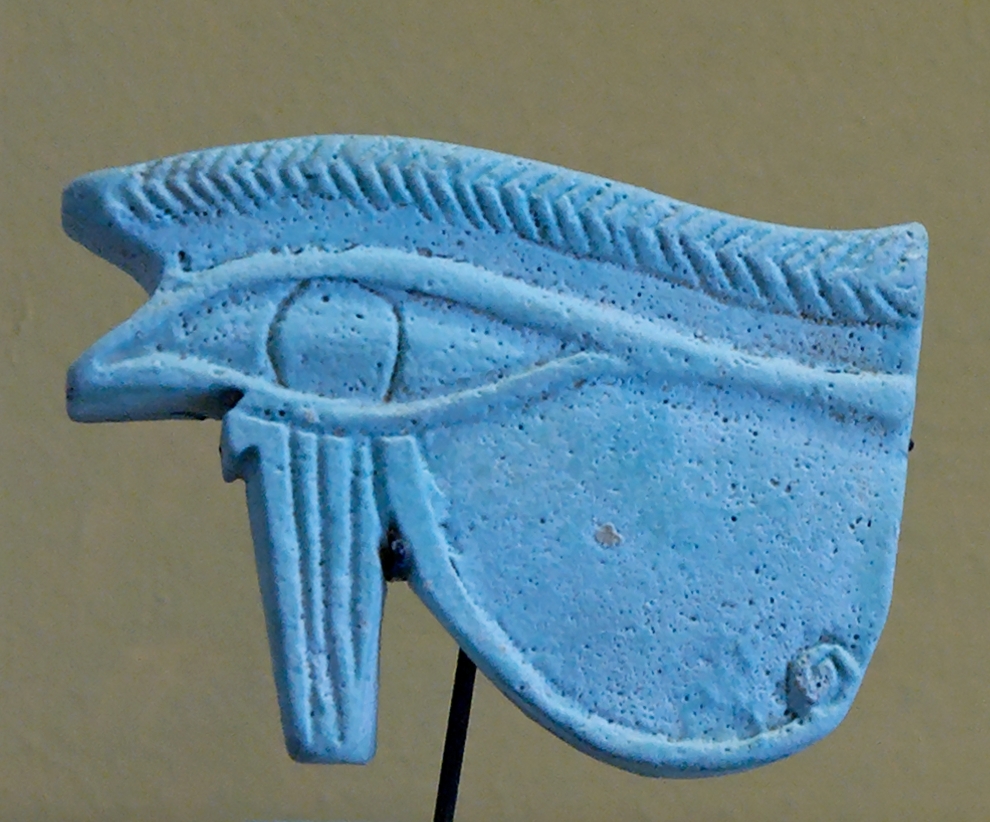
Casimiro’s elder brother, Lucio, a poet who had a brief flash of fame in the Fifties, was as solitary, odd-looking, and idiosyncratic as himself, and the siblings lived alone with their twenty servants, in the midst of a park with rare shrubs and cacti from all over the world, their beautiful summer villa filled with a vast library of science, art, and literature, and marvellous things. They slept in beds as narrow as a discalced Carmelite’s, and never married. They loved their dogs, and gave them names that are mostly monosyllables, often sort of orientalised in a troubling way. They range from ‘Aladdin’ to ‘Mameluk’ to ‘Book’ and the brothers built them a cemetery of their own in the garden.
Casimiro was a follower of Paracelsus, who had distinguished the elemental beings as animating matter: gnomes, undines, sylphs and salamanders. Salamanders, in the form of darting, wriggling lizards, are plentiful on the baked stones of the south, but the others are the cousins of imps and elves, sprites and sirens, and they’re not so common. The journal Psychic News, to which Casimiro subscribed, inspired him to try to take photographs of the apparitions he saw in the park of exotic plants around the house. He also ordered various publications of the Society of Psychical Research and other bodies who tried to tap immaterial presences and energies. He was hoping for images like the famous Cottingley images of fairies sunbathing or dancing which Conan Doyle so admired. But he had no success. Instead, he painted: a fairy punt poled by a hobgoblin through the lily pads, a fairy doctor with a bag full of shining golden instruments taking the pulse of a turkey, four old gnomes consulting a huge grimoire held up by imps, etiolated genies, turbaned potentates, and eastern sages. He rarely left Sicily, or indeed, his family home, and he went on painting his sightings in soft, rich watercolour from 1943 to 1970 when he died.

His work looks like Victorian or Edwardian fairy paintings. Had this reclusive Sicilian seen the crazed visions of Richard Dadd, or illustrations by Arthur Rackham or John Anster Fitzgerald? Or even Disney? Disney was looking very carefully at picture books when he formed the famous characters and stamped them with his own jokiness. Casimiro doesn’t seem to be in earnest, and the long-nosed dwarfs look a little bit like self-mockery. It is impossible to know what he meant, if he meant what he said, or what he believed. But the fact remains, for a grown man to believe in fairies strikes us now as pretty silly.
The Piccolo family’s cousin, close friend and regular visitor was Giuseppe Tomasi di Lampedusa, the author of The Leopard, and he wrote a mysterious and memorable short story about a classics professor who once spent a passionate summer with a mermaid. But tales of fairies, goblins, and gnomes seem to belong to an altogether different degree of absurdity from a classics professor meeting a siren.
And yet, the Piccolo brothers communicated with Yeats, who held all kinds of beliefs. He smelted his wonderful poems from a chaotic rubble of fairy lore, psychic theories, dream interpretation, divinatory methods, and Christian symbolism: “Out of the quarrel with others we make rhetoric; out of the quarrel with ourselves we make poetry.”
Featured image credit: Capo d’Orlando, by Chtamina. CC-BY-SA-2.5 via Wikimedia Commons
The post Once upon a time, part 1 appeared first on OUPblog.
Blog: Stacy A. Nyikos (Login to Add to MyJacketFlap)
JacketFlap tags: Cinderella, Rapunzel, Little Red Riding Hood, chronicle, trilogy, Cinder, Scarlet, Marissa Meyer, Cress, meet-cute, Add a tag
Cinder, Scarlet & Cress
Marissa Meyer
YA
This review has me torn. On the one hand, I really enjoyed the first book in this series, Cinder. On the other hand, I had a hard time moving from book 1 to book 2 because main protagonists change. Is this a revolutionary way to avoid the sequel slowdown? Or does it kill the reading momentum?
But one thing at a time. First, Cinder.
Basic premise: A retelling of Cinderella as a cyborg/lunar girl living in a future Beijing in which the Queen of the Moon threatens to attack and enslave (or destroy) earth. Cinder, a mechanic and adopted daughter of the archetypically evil stepmother and one evil stepsister and one nice stepsister, is (spoiler alert!) secretly the rightful heir to the lunar throne. She doesn't know it yet. She thinks she's just a mechanic, who is also partly cyborg, and thus despised by most. Cyborgs are considered de-humanized by the cybernetic parts. Add to that, earthens suffer a plague caused by a viral strain introduced by runaway lunars.
As Fate would have it, the crown prince, Kai, is looking for the lost lunar heir, and comes to Cinder to repair a broken android that may hold the answers to the lost princess's whereabouts. Cue: meet-cute.
The rest of the book is action-packed unraveling of the plague, who the princess is, the love interest between Cinder and Kai that all lead up to the annual ball where (spoiler alert!) the princess does not get her prince. In fact, he sacrifices her to the Lunar Queen to save earth.
Despite how much is going on in this story, it held my attention and was a fun read. Definitely a dessert book. My youngest loved the book so much, she asked if we could get the second book. We listened to both as audio books. We got it. We almost didn't get through.
Scarlet begins with a wholly different protagonist, namely, a character based on Little Red Riding Hood, with a parallel story about the people who helped Cinder escape from the moon, hide her and transform/heal her as a cyborg. It was very jarring to trade out one main protagonist for another, and in this instance, Scarlet is a very angry 18 year old, which makes it hard to feel empathy for her. She constantly lashes out. But we stuck with it (partly due to a very long car ride) and eventually, about halfway through the book, were able to listen without checking the clock.
I'm not sure I'd have bought the third book, but Scarlet ended in the middle of said long car trip, so we did. Cress follows the same pattern as Scarlet, introducing yet another new main protagonist and another retelling of a fairy tale, Rapunzel.
All of the main female lead's stories are connected and interwoven. The writing is tight and filled with action. And I admire Meyer for coming up with a novel way to avoid the sequel slowdown. I'm not sure introducing a new protagonist as the lead works particularly well. The reader is forced to alter heroes from one protagonist to another, while also following the original protagonist's main story as it unfolds in a sort of b-story role. Clearly, these books have sold exceptionally well, so something is working. Maybe it's my misperception that I'm getting hung up on. This isn't a trilogy. These are chronicles, loosely related stories that are nevertheless connected and do move forward toward a common goal. Still, it was jarring to move from book 1 to 2. And yet, here I am on book 3. Like I said, these books have me torn.
For other great May treasures, click on over to Barrie Summy's website. Happy reading! Add a Comment
Blog: Ink Splot 26 (Login to Add to MyJacketFlap)
JacketFlap tags: fractured fairy tales, little red riding hood, Sneak Peek, Reads, grimmtastic girls, Add a tag
Red Riding Hood Gets Lost
Tomorrow are the auditions for the school play at Grimm Academy, and I can’t wait to try out! I want to play the lead, Red Robin Hood. But it’s my first time auditioning and I’ve got stage fright! How grimmiserable!
It doesn’t help that my friends and I are all worried about the E.V.I.L. Society that’s making trouble at the Academy. If only I had a magical charm to help us figure out what’s going on – and maybe help me get the lead in the play!
Any suggestions to help me get over my stage fright? I’m so glad I have my grimmtastic friends Cinda, Snow, and Rapunzel to help me out. I know I can always count on them!
Love,
Red
Blog: My place over the hill (Login to Add to MyJacketFlap)
JacketFlap tags: Picturebooks, ediciones sm, caperucita roja, children's books, Wolf, children's illustration, little red riding hood, Add a tag
First thing I decided to do is give Little Red a puppy. He is smart and unlike Little Red, he is suspicious of strangers. I thought it would give a clue to little kids reading the book. Believe me, kids always notice the tiny details.
I wanted wolf to have clothes and look like a "normal" fellow. The point of this story is to show that even normal looking strangers could be dangerous. So Wolf is wearing a top hat, jacket and a bow tie. Bit sofisticated fellow huh? ;o)
These two are my favorite illustrations in the book. :o)
It was a challenge to follow the story and not illustrate too dark or scary. I always like to think of my audience, in this case is very little kids.
And grandma was so much fun to illustrate, hehe!
I have to thank my editor Teresa for always believing in me and giving me complete free range. This is what all illustrators dream of having.. and I can't thank her enough for trusting me with all books we work on.
If you'd like to purchase Caperucita Roja it will be available March 5th. :o)
Blog: My place over the hill (Login to Add to MyJacketFlap)
JacketFlap tags: classics, little red riding hood, children's illustrations, alicia padron, ediciones sm, caperucita roja, cuentos de ahora, Add a tag
Despite the fact that most of the major streets are blocked and there are protests occurring in different parts of the country, by some amazaing miracle my complimentary copies of Caperucita Roja -Little Red Riding Hood- have arrived today!
The book turned out so lovely, I am really so pleased. It is published by Ediciones SM Spain and will be available March 5th. This book belongs to a series of books called -Cuentos De Ahora-
What a wonderful surprise to get these books at a moment like this.. Really made my day!
I'll post more about the making of this picture book and will show a little more of the inside illustrations soon. :o)
Blog: The Children's Book Review (Login to Add to MyJacketFlap)
JacketFlap tags: Giveaways, Fractured Fairy Tales, Little Red Riding Hood, Melissa Sweet, Joan Holub, Handwriting, Add a tag
Enter to win a Little Red Writing prize pack. Giveaway begins September 15, 2013, at 12:01 A.M. PST and ends October 13, 2013, at 11:59 P.M. PST.
Add a CommentBlog: A Fuse #8 Production (Login to Add to MyJacketFlap)
JacketFlap tags: Uncategorized, Little Red Riding Hood, obits, William Steig, Leslie Connor, Chris Van Allsburg, Don't Let the Pigeon Drive the Bus, Fusenews, book to film adaptations, Jumanji, Thomas Locker, Add a tag
 In a weird way, Twitter sort of made my Fusenews posts this side of obsolete. If you want cool things to see online it’s often just a case of knowing whom to follow. And yet I love my little Fusenews. Pressed as I am for time today, let’s pretend that these are little tweets:
In a weird way, Twitter sort of made my Fusenews posts this side of obsolete. If you want cool things to see online it’s often just a case of knowing whom to follow. And yet I love my little Fusenews. Pressed as I am for time today, let’s pretend that these are little tweets:
Pinterest continues to remain a strange elusive creation that I have a hard time wrapping my head around. Fortunately sometimes it will do something like post images from William Steig’s Agony in the Kindergarten (circa 195o) and all at once everything is clear. Thanks to Alex Penfold for the link.
And while you’re looking at vast numbers of images, why not look at this collection of international children’s art. Purdy. Thanks to Warren Truitt for the link.
Adrienne says, “I Can’t Imagine There Was Ever a Time in Which This Version of Little Red Riding Hood Wasn’t Creepy.” I don’t quite know what she means since I haven’t yet seen the . . . GAAAAAHHHHH!!!
- I want a new Leslie Connor middle grade novel for kids and I want it now now now now now. (This is called “baiting the universe” and should only be attempted under the strictest of circumstances.)
- Was anyone else aware that Thomas Locker died this year, or just BookMoot? First I’ve heard of it. Shoot.
- As per usual, the best round-up of the year is happening at Chicken Spaghetti. If you want to see every last Best Of list printed for 2012 books, seek ye no further.
- Speaking of Best Of lists, I am not usually flummoxed by the books folks pick. I like to think that on the children’s side I see almost everything. So imagine my flummoxing when I check out the 100 Scope Notes Top 20 Children’s Books of 2012 and find that #20 is a book I have NEVER heard of before!?! I am tongue-tied, stopped, and otherwise befuddled. You win this round, Jonker, but I shall have my revenge!!
- The Bookbug children’s bookstore in Kalamazoo, Michigan does many things right. But most recently they managed to make this remarkable little fellow:
Don’t try to buy him for your holiday shopping, though. Apparently to make it you need to get “many different packages of legos from several different vendors.” Worth it.
- You know how weird it was when they redid Spiderman with an all-new cast? Yup. Well, hold onto your hats, folks. A children’s book is getting yet another reworking as well. From Cynopsis Kids:
Columbia looks to Zach Helm (Stranger Than Fiction, Mr. Magorium’s Wonder Emporium, which he also directed, and the upcoming The Secret Life of Walter Mitty) to write a new big screen adaptation of Jumanji, based on Chris van Allsburg’s 1981 book of the same name, per THR. Matt Tolmach (The Amazing Spider-Man) will produce the new Jumanji movie. Joe Johnston directed the 1995 feature film incarnation of Jumanji, which starred Robin Williams and Kirsten Dunst.
- Daily Image:
There is a giant swing installation somewhere in New York City right now. You walk in, you sit, and you swing.
I may have missed the Columbus Circle installation but by gum I am finding this one! Thanks to Crooked House for the heads up.
Blog: DRAWN! (Login to Add to MyJacketFlap)
JacketFlap tags: art, little red riding hood, fairytale, snow white, red riding hood, daniela terrazzini, illustration, fairy tales, Add a tag
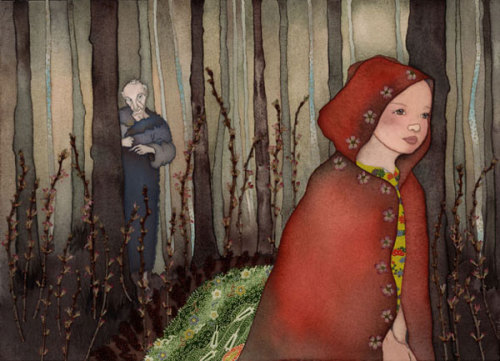
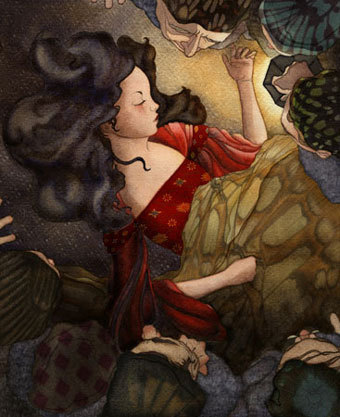

art by Daniela Terrazzini
Blog: Gigi's Studio (Login to Add to MyJacketFlap)
JacketFlap tags: woods, little red riding hood, promotional, trees, flower, whimsical, fog, foggy, in from my studio, animal, Illustrations, children's illustration, digital, Children's Illustrations, dark, fairytale, basket, In From My Studio…, illustrator, food, girl, wolf, flowers, photoshop, nature, people, Add a tag
After some back and forth, I finally dececided on the illustration I wanted to use as my new promo postcard. I finished this piece in the wee hours of Monday morning. I was kind of surprised I sat here Sunday night and worked on this. I rarely paint on Sunday […]
Blog: The Art of Children's Picture Books (Login to Add to MyJacketFlap)
JacketFlap tags: Little Red Riding Hood, Brothers Grimm, Add a tag
Blog: A Mouse in the House (Login to Add to MyJacketFlap)
JacketFlap tags: illustration, children's illustration, little red riding hood, digital art, roberta baird, artwork, houston, a mouse in the house, Doodle Diner, www.robertabaird.com, tell a fairy tale day, Add a tag
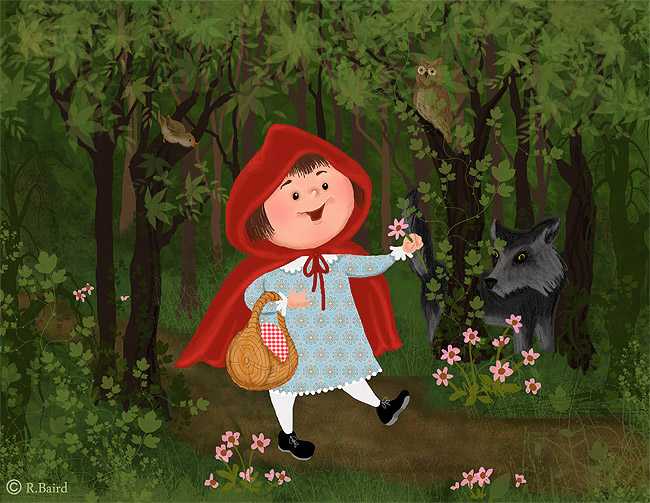
The sun was shining brightly, but it was not too warm under the shade of the old trees, and Little Red Riding-Hood went on her way singing and gathering great bunches of wild flowers to give to her grandmother. She sang so sweetly that a cushat dove flew down from a tree and followed her.
Now, it happened that a wolf, a very cruel, greedy creature, also heard her as she passed, and longed to eat her for his breakfast, but he knew Hugh, the woodman, was at work very near with his great dog, and he was afraid they might hear Little Red Riding-Hood cry out if he frightened her, and then they would kill him. So, after following her a little way, he came up to her very gently and said, “Good day, Little Red Riding-Hood, where are you going?”
We’re celebrating Tell a Fairy Tale Day on The Doodle Diner! Grab a cup o joe and see what else is on the grill with all my other Doodle Diners peeps!
Blog: Biblio File (Login to Add to MyJacketFlap)
JacketFlap tags: YA, Fiction, Fairy Tales, Little Red Riding Hood, Vivian Vande Velde, Add a tag
Cloaked in Red Vivian Vande Velde
From the introduction (after several hilarious pages deconstructing "Little Red Riding Hood"
Okay, think about this. What makes a good story?
1. Memorable characters
We've got a mother, Little Red Riding Hod, a wolf, a grandmother, and a woodcutter. It's hard to call characters memorable when the only one who has a name is, in fact, named after apparel that nobdoy wears anymore.
2. Vivid setting
The woods. Okay, are we talking Amazon rain forest here or a couple of trees in someone's backyard? It's sloppy storytelling if we aren't given enough information to picture where our memorable characters are.
3. Exciting plot
Try submitting a story to your creative writing teacher in which the main character bumbles cluelessly throughout the story, then gets rescued by another character who was never mentioned before. Go ahead and keep your fingers crossed for a passing grade.
4. Important themes--something about the subject to captivate our imaginations and connect with those who read the story.
It's hard to determine the theme of "Little Red Riding Hood." Don't go into the woods? Don't talk to animals who are capable of talking back? If you're going to make fun of your grandmother's appearance, make sure it truly is your grandmother and not a wolf who likes to dress in old-ladies' clothes?
However you look at it, "Little Red Riding Hood" is a strange and disturbing story that should probably not be shared with children.
That is why I've gone ahead and written eight new versions of it.
And eight wonderful new versions is what Vande Velde gives us. We have sinister wood cutters and bumbly blind ones. We have girls in the wood who are unsure of themselves and those who know exactly what they are doing. We have wolves of hunger, friendly wolves, werewolves, and wolves made of rags. We have cloaks that are smarter than their owners, cloaks that are altogether the wrong shade of red, and even one that is actually green.
Vande Velde takes us through several versions of the story, all of which make a lot more sense than the original. It's often funny and at times a bit scary. Each story focuses on a different aspect of the story-- Red's family, the woodcutter, grandmother, the wolf, the cloak... all with excellent results.
I love Vande Velde's take on the issues with the original and her ideas on how to fix the story. I enjoyed every version and this is a must-read for fairy tale fans.
Book Provided by... my local library
Links to Amazon are an affiliate link. You can help support Biblio File by purchasing any item (not just the one linked to!) through these links. Read my full disclosure statement.
Blog: B is for Books (Login to Add to MyJacketFlap)
JacketFlap tags: Little Red Riding Hood, children's book, children's book reviews, Old School, Little People: Ages 4 to 8, Once Upon a Time..., Thao Lam, Add a tag
I don’t know how many versions of “Little Red Riding Hood” I have, but I couldn’t stop myself when I found this 1960s version in the collection of children’s books I came across at the St. Lawrence Antique Market. Read more after the jump. This copy of “Little Red Riding Hood” was obviously well loved because [...]
Add a CommentBlog: Musings of a Novelista (Login to Add to MyJacketFlap)
JacketFlap tags: Books, Werewolves, Little Red Riding Hood, Jackson Pearce, Sisters Red, Add a tag
I found Sisters Red by Jackson Pearce during one of my bookstore browses — pleasantly surprised that I found it out in the wild before the actual pub date. I already knew that it was a retelling of “Little Red Riding Hood” — and after reading the prologue in the bookstore, I was hooked. Scary, suspenseful, and edgy — a great combination for a fabulous read.
 The story centers around two sisters. Brooding Scarlett who saved her sister’s life when a murderous Fenris (aka werewolf) invaded their grandmother’s house. She was horribly disfigured and now has made it her mission to kill every Fenris she can. Loyal Rosie is grateful for her sister’s sacrifice and joins in the hunt to lure and kill the Fenris despite that she yearns for a normal life.
The story centers around two sisters. Brooding Scarlett who saved her sister’s life when a murderous Fenris (aka werewolf) invaded their grandmother’s house. She was horribly disfigured and now has made it her mission to kill every Fenris she can. Loyal Rosie is grateful for her sister’s sacrifice and joins in the hunt to lure and kill the Fenris despite that she yearns for a normal life.
I love how Jackson Pearce portrays the sisters. Scarlett was my favorite — she knows her role and she is laser-focused on killing the Fenris because she knows first hand of their dangerous cruelty. Make no mistake about the Fenris — they are ruthless, deadly, and will feast on innocent lives if left unchecked. Younger sister Rosie is fiercely loyal but she is also falling in love with the woodsman’s son who’s returned from the West Coast. Rosie is also realizing that there could be more to life than hunting the Fenris.
I also really loved that the story is set in rural Georgia and later in midtown Atlanta. I recognized several of the locations, which are not far from my office. It was great seeing Atlanta being almost another character in this novel.
This book is filled with dramatic action scenes and suspense. As a writer, there is a lot to learn from the structure. I enjoyed this retelling a lot and I will probably never look at a red cape the same way again.
Blog: A Mouse in the House (Login to Add to MyJacketFlap)
JacketFlap tags: illustration, Illustration Friday, IF, children's illustration, little red riding hood, digital art, roberta baird, artwork, trail, houston, a mouse in the house, wolfe, Into the Woods, Add a tag

Into the woods, It’s time to go,
I hate to leave, I have to, though.
Into the woods- It’s time, and so
I must begin my journey.
Into the woods And through the trees
To where I am Expected ma’am,
Into the woods
To Grandmother’s house-
Lyrics by Stephen Sondheim for Into the Woods
Blog: It's A Whimsical Life (Login to Add to MyJacketFlap)
JacketFlap tags: woodsman, Little Red Riding Hood, granny, red riding hood archive, Add a tag
Last year, I was asked to make a Red Riding Hood doll and the wolf for a Red Riding Hood archive in a Connecticut library: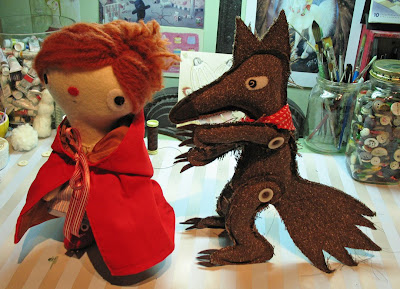
The library recently got back to me and asked if I would be interested in making the granny, the woodsman and a cat to go with them. I started the granny and woodsman a while ago, but have taken ages to start putting them together. So I finally sewed them up and stuffed them:
Attached the limbs:
Starting adding the features (I love this part!):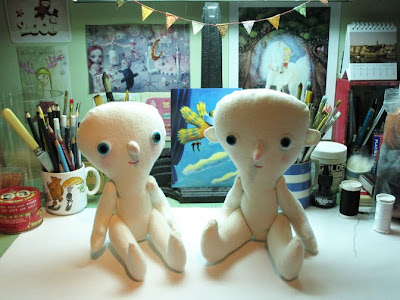
Because they start to come to life: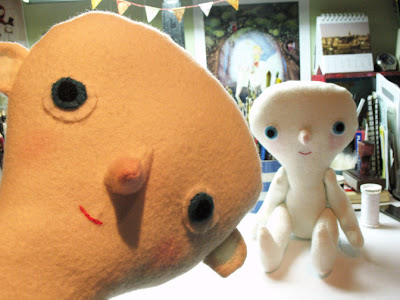
Next step, more fun stuff: clothing, hair and the woodsman is going to have a serious moustache and beard :)
View Next 6 Posts



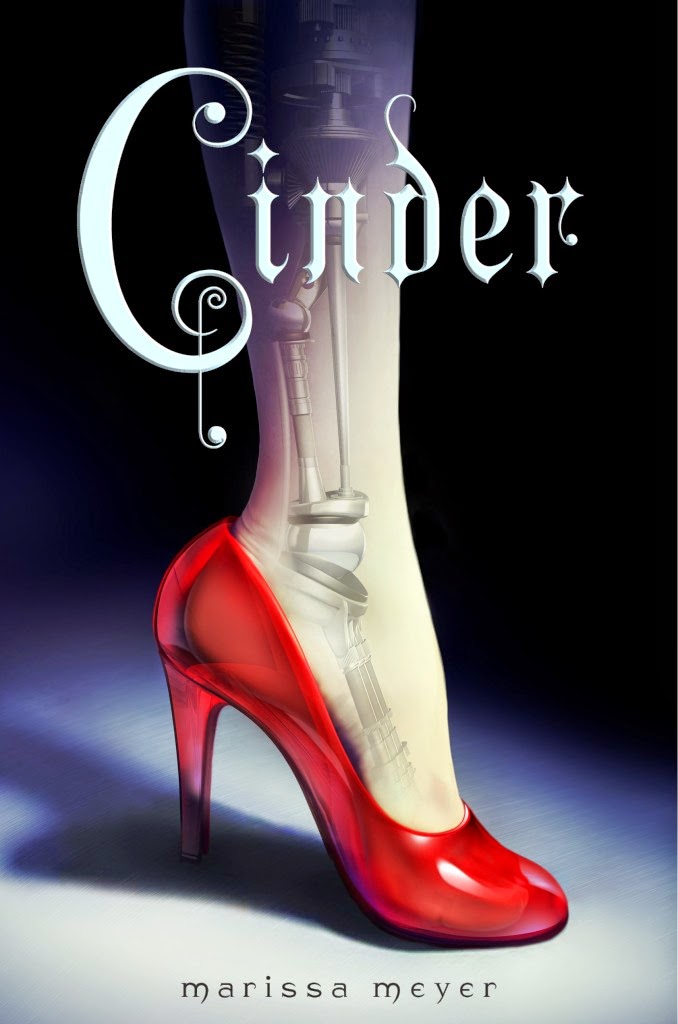

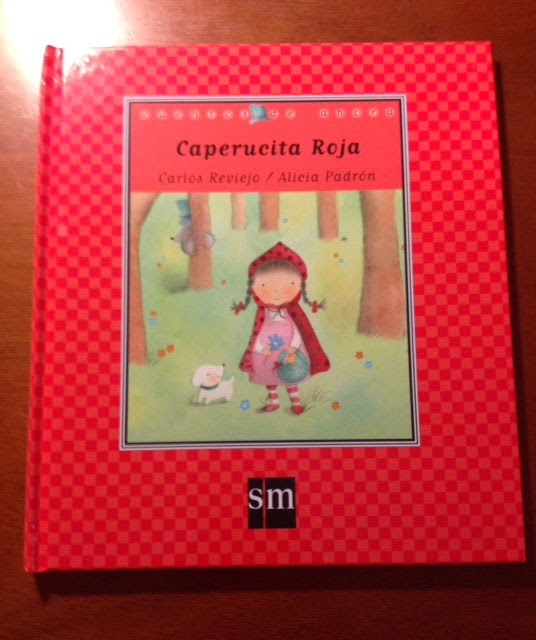
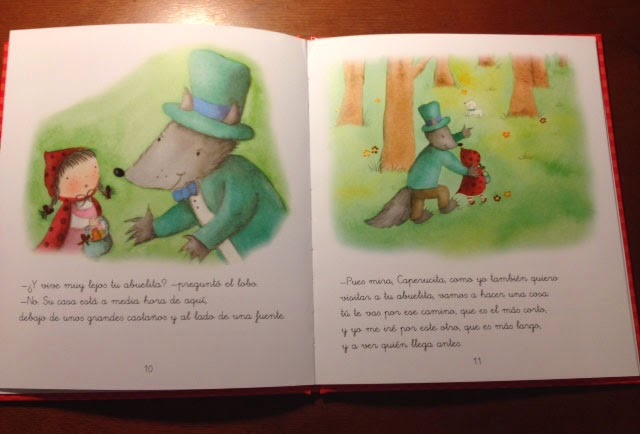

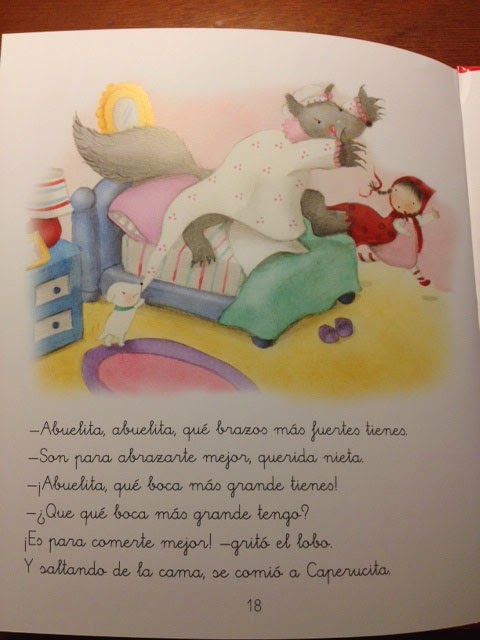




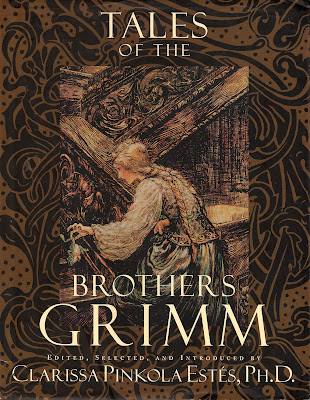

great post! BTW, did you came across any Red Riding Hood picturebook with scary illustrations, such as the wolf eating humans or the wolf being pictured with a fat stomach? Thanks in addvance!
kelly
No, but I wasn't looking for that. Thanks!